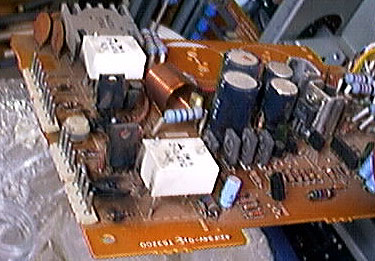
It is very unlikely that the Sanyo Corporation, nor any of the many other similarly-affected audio manufacturers, nor even the company (-ies?) that supplied the glue, had any idea of the extent of the havoc and mayhem they were unleashing upon the world, a generation ago. It started out innocently enough: all they wanted to do was fasten down some of the bigger electronic components during the wave soldering process, to ensure that they would be positioned and soldered correctly.
Presumably unbeknownst to anyone until years later (when it was too late), the chemical composition of the glue was such that, exposed to years of heat, it “broke down” and became conductive. Starting out with a golden color, the glue would turn progressively darker: medium brown, dark brown, eventually virtually black. As it did so, it became more conductive. As it became ever more conductive, the glue created new, unintended phantom electronic “components”, changing the circuit to something never intended by its designers!
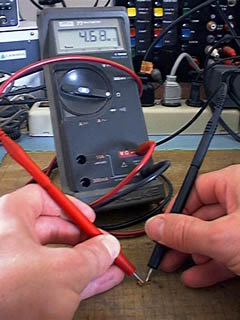
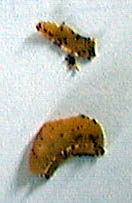
The photos above show a highly finite resistance reading on a not-too-dark piece of conductive glue, and a closeup of two pieces of conductive glue. The bottommost piece in the closeup is the one being measured.
Used by most, if not all, Asian audio manufacturers from the very late 1970s until around the mid 1980s (when its harmful properties were fully understood and alternatives made available… yet apparently it lives on in the current millennium), conductive glue has no doubt caused any number of audio components to die an untimely death… or at least annoy the bejesus out of owners with odd, phantom noises and other failures.
I first learned of conductive glue from a wise Japanese technician working for the Kyocera Corporation, who was helping me with a seemingly insoluble problem with noise in a Kyocera DA-910 (or 810—i don’t recall) CD player. Due to language difficulties and disbelief that there was such a thing as “conductive glue”, it took me awhile to realize the full import of what i had just learned.
A Case History of Carnage
This section is a photo essay concerning the most recent victim of conductive glue: a Sanyo Plus 130 receiver belonging to a good friend of mine, whose right channel power amp was smoked by conductive glue. The lead photo of this page shows a side view of the damaged amplifier P.C.B. Here’s “helicopter” view, a bit closer, with descriptive text:
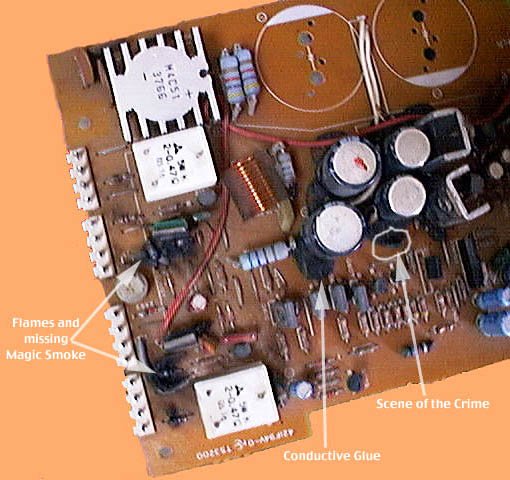
After 20+ years of heat, the conductive glue really has become about as black as it appears in the photo. Many portions of it read less than 1 megohm resistance! The Sanyo Plus 130 design places individual power supplies on each power amplifier P.C.B. The right channel also contains the shared low-voltage supply for the set, and that is precisely whose capacitors are being held by the conductive glue. Had the glue had the decency to remain just in the low voltage power supply area, there might not have been a problem. But nooooooo… it had to work its way to “The Scene of the Crime”: a small compensation capacitor in the input stage of the right channel power amp (barely visible just above the arrow tip in the photo).
As if that were not enough (and trust me, that was plenty bad!), there was some additional conductive glue on the foil trace side of the P.C.B. (not photographed) on some production-line add-on components... in the same, very sensitive, part of the circuit! This amplifier had no chance!
The flameouts and smoked components are fairly typical of any discrete audio power amplifier (or would that be amplifire?![]() ) which has severely “blown up” for any reason (shorted speaker wires, run too long at too high an output, defective speakers, poor design,...). Here is some more smoke damage, this time on the heatsink-mounted output transistor P.C.B.:
) which has severely “blown up” for any reason (shorted speaker wires, run too long at too high an output, defective speakers, poor design,...). Here is some more smoke damage, this time on the heatsink-mounted output transistor P.C.B.:
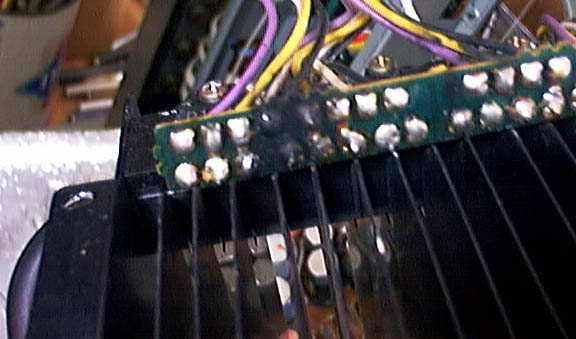
Beware Conductive Glue!
If you are the owner of any still-operating audio equipment which was originally manufactured between about 1979 and the mid-1980s, you have reason to be concerned about conductive glue. Anything older or newer did not use conductive glue, and is therefore immune from its influences (though apparently this adhesive is not yet extinct in areas outside of audio equipment).
Owners of tuners, cassette decks, CD players, preamplifiers, and other low power items need only be aware that conductive glue may be a source of failures. It is extremely unlikely that these failures would cause any significant circuitry damage. For these types of devices, it is usually best to ignore the situation unless/until there are some problems, such as unintended noises from the speakers, or other types of electrically-related improper operation.
Owners of anything using higher power circuitry, such as receivers, power amplifiers, and integrated amplifiers, have good reason to be concerned, and consider preemptive maintenance. If this page does not contain enough information for you to sufficiently understand what conductive glue is, how to find it, and how to eliminate it, it would be best to seek the help of a skilled electronics technician, preferably one experienced with home audio electronics. Not all components from the affected era contain conductive glue. Still, if you have some of this older high-power equipment which is working and which you cherish, it will be much more cost-effective to find out BEFORE the “magic smoke” escapes, when the cost is nominal, rather than AFTER, when the cost may be substantial.